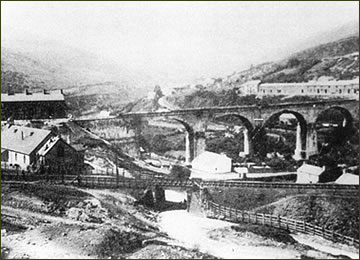Afan / Nedd
Afan Nedd
RIVER AFAN Auan, Auen c.1150, Hist. Margam, 24. Aven a. 1167, Hist. Margam, 35. The two rivers of Avana 12th cent. Hist. Margam, 135. The Great Aven 1208 Hist. Margam, 181. Avyn 14th cent. R.B.B. 412. Avan, Aven 1443 Hist. Margam, 344. Avan 1455-85 L.G.C. 84. Avon, Avon Vaur, Avon Vechan 1536-9, Leland, 29, 30. Avan Fechan alias Abergwenffrwd 1601 Bushby Coll. The River Avan, Avan Fechan c.1700, Lhuyd Paroch. III. 6. This river rises on Crug Afan in Blaen Afan and flows by Cymer Afan (where it is joined by the Corrwg stream) and Pont Rhyd-y-fen, through Cwm Afan onwards to Llanfihangel Ynys Afan (Michaelston-super-Avan) and into the sea at Aberafan. The Afan Fechan (the lesser Afan) joins the Afan at Cymer Dwy Afan in Pont Rhyd-y-fen. There is an old chapel dedicated to Illtud at Argoed Afan. Afan is not confined to the Neath-Port Talbot area. It occurs as a pers. name in Afan Ferddig, also as a saint's name in the churches at Llanafan Fawr and Llanafan Fechan (Brecs.), known today as Llanfechan, and in Llanafan (y Trawsgoed) (Cards.). The saint is presumed to be Afan Buellt, a reputed Bishop of Llanbadarn fawr, (Cards.) One etymology links Afan with the Latin Amandus, but Avan occurs in Breton as a masc. and fem. pers. name, with its Scottish equivalent as saint Aban or Abann; while Abana is a Gallic fem. pers. name. If the Afan pers. name is seen here as the Afan river-name, then it is another example of a pers. name standing alone as a river-name as in Bradach, Adda, Alun, Beuno, Cynfael, Cynon, Dewi, etc. having lost the accompanying afon or nant. It is also possible that afan emanates from old Irish abann ‘river'. It would appear then to be either a borrowing from Old Irish, or descended from a form that was at one time, common to all Celtic languages. The Welsh coll. or pl. n. afan ‘raspberries', must also be remembered. The examples recorded at the top of the page show that this river-name (which was also the name of the commote or lordship) had varying early forms of Afan, Afen Afyn although Afan alone survived. These different forms were the effects of a lost ultimate vowel. Or is the reason for the Aven form (that occurs mainly in official documents) the fact that Aven or Afene, a weakening of the earlier Afone form, is the most common form used in Mid. English for the numerous Avon rivers in England? The above is a translated and paraphrased account of R. J. Thomas's article in EANC pp35-36. This is the most comprehensive and detailed discussion that I have read on this river-name. Most present day toponymists tend to favour the Afan pers. name etymology. [ see HWO & RM in DWPN; Howard Jones in Place Names in Glamorgan; MR in The Names of Towns and Cities in Britain.] Port Talbot philologist Alwyn B. Jones however favours Taliesin ab Iolo's a and ban ‘from the heights'. Cwmafon and Aberafon are relatively recent forms for the earlier and more accurate Cwmafan and Aberafan. [The Port Talbot name was coined in 1836 when new docks were constructed at the mouth of the river Afan for exporting coal and iron. The docks were named after the Talbot family who, through marriage, had inherited the old Margam and Penrhys estates.] Whatever the etymology, the River Afan contains an old, respected and continuous place-name element. It should not be confused with afon, the Welsh word for ‘river'. Afan has been in use for hundreds of years, since its inception during the early middle ages. Let us respect its history and preserve its longevity. DMJ. March 2009. --------------------------------------------------------------------------------- SEVEN SISTERS / BLAENDULAIS Mr. Evan Evans and his nephew Mr. David Bevan were the eponymous Evans and Bevan of the Vale of Neath Brewery in Cadoxton. They also built an ‘anthracite empire’ in the Dulais Valley. Seven Sisters was the bright idea of David Bevan’s only son Evan Evans Bevan, who suggested at the opening ceremony in 1872, that the Dylais Valley Colliery be named after his ‘seven sisters’. The pit was in production by 1875 and by 1882, the village had adopted the colliery name. The earlier name for the land around the colliery was Blaendulais, as it was located at the head of the Dulais stream. Today the village is known as both Seven Sisters and Blaendulais. BANWEN blain peurdin 12th cent. LL Pewerdyn 1468 CMG MRA Pyrthyn 1539 Penpont NLW Pyrddyn 1628 John Jenkins NLW Gwayne Banwen 1722 Penrice and Margam Panwaun Byrddin 1799 Yates Banwen (dwelling) 1806 Miers Panwen Byrddin 1814 GVADESW Tavarn y Banwen 1831 ibid Coal under Banwen Burthin 1819 Cambrian Banwen Ironworks 1844 Banwen History online Banwen Colliery 1845 Neath History online Banwen Pyrddin 1991 OS Pathfinder 1108 Banwen 1991 ibid Banwen is the name of a small anthracite mining village located on moorland between Seven sisiters/Blaendulais and Glynneath/Glyn-nedd. The moorland is known as Banwen Pyrddin. The banwen place-name element is found elsewhere in south



